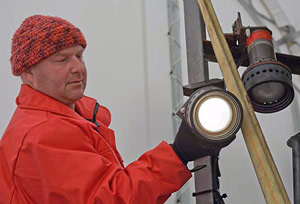|
Interview with Tim Shank by Lonny Lippsett, photo by Chris Linder 
WHOI biologist Tim Shank tests a light on the Camper vehicle, getting it prepared for missions to photograph and sample rocks and animal life around hydrothermal vents, if we find any. What is your role on this expedition? What kinds of conditions are those? How? Prior to the discovery of hydrothermal vents, it was widely held that life really didn’t exist without the use of the sun, that it was mostly a desert (albeit a diverse one) at the bottom of the ocean, and that deep-sea animals survived off organic debris that rained down from the surface. But vents changed all of that. Nutrients were coming up from inside the Earth that life could make use of. They didn’t really need the sun, except for some oxygen. And the seafloor turned out to be a highly dynamic place. Where are hydrothermal vents found on the seafloor? Different types of species are found only in certain places. So along the East Pacific Rise, (the mid-ocean ridge in the eastern Pacific Ocean), and along South America, down from Galápagos Islands, we find areas dominated by tubeworms, large clams, and mussels. But if we go up north, off of the coast of Oregon and Washington, the ridge has a different species of tubeworms than what we see in southern Pacific, and a notable lack of mussels. In Atlantic Ocean vent sites, it’s completely different. We don’t see any tubeworms. The Atlantic is dominated by huge swarms of shrimp. If we go to the western Pacific, those vent sites over there are dominated by different species of hairy gastropods—those are large snails. So one of the vexing questions we’ve had for a long time is what causes and maintains these so-called biogeographic provinces? How do populations on the seafloor get separated so that different species evolve? That’s why the Artic Ocean is one of the key places to explore. Explain. When seafloor spreading began in the Arctic some 58 million years ago, the Arctic Ocean basin was almost completely isolated from any water connection to the Atlantic or the Pacific. It has only been for the past 19 million years or so that a small amount of deep water has flowed into the Arctic from the Atlantic, so whatever life has been evolving along the deep Gakkel Ridge has likely been doing so for tens of millions of years or so in isolation from other oceans. That leads us to ask, “Well, what fauna is going to be in the Arctic?” We really don’t know. It’s sort of like thinking about Australia and how 100 million years ago that became disconnected from Antarctica, and now we’ve got kangaroos there, and only there. We’ve got koalas and all kinds of different animals that we don’t see anywhere else. So what is the evolutionary history of the animals that live in the Arctic, on the Gakkel Ridge? That’s what we’re trying to find out. I have no idea what the Arctic animals are going to look like. I have to forget my preconceived notions. But it’s safe to say that, if they’re there, they’re going to have novel adaptations. They may do things that we may not even know about yet. They may be living off nutrients that we haven’t discovered yet. So it’s a dream for an evolutionary biologist like myself to be able to go there and find those animals. (continued) Page [ 1 ] [ 2 ]
|
Mailing List | Feedback | Glossary | For Teachers | About Us | Contact
© 2010 Dive and Discover™. Dive and Discover™ is a registered trademark of Woods
Hole Oceanographic Institution
